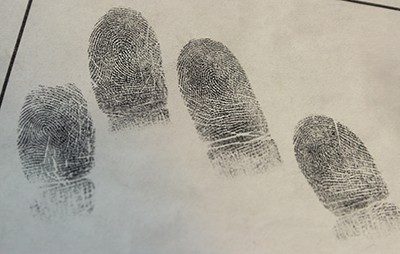FOR IMMEDIATE RELEASE | September 21, 2022
How old is that fingerprint?
“Novel Ambient Oxidation Trends in Fingerprint Aging Discovered by Kendrick Mass Defect Analysis”
ACS Central Science
Forensic dramas on TV make it seem easy to determine when fingerprints were left at the scene of a crime. In reality, the oils in fingerprints degrade over time, and it’s difficult to figure out their age. Now, researchers reporting a small-scale study in ACS Central Science have discovered molecular markers for changes to these oils over a seven-day time period — information that could be used to estimate fingerprints’ ages more accurately.
Identifying the age of fingerprints at a crime scene is extremely important evidence when trying to figure out who was really there when the wrongdoing was committed. Previously, Young Jin Lee and colleagues showed that triacylglycerols found in fingerprint oils react with ozone in the air, forming oxidation products, whose presence could be used to estimate when prints were deposited. But ozone reacts with other oils, such as squalene, wax esters, fatty acids and diacylglycerols, generating a complex mixture of oxidation compounds. So, Lee and Andrew Paulson wanted to develop a method to decipher that mixture of compounds and find molecular markers that could more precisely estimate the age of a fingerprint.
The researchers had a volunteer place 14 of their thumbprints on glass slides, which were left in the open air at room temperature for up to seven days. Then the team analyzed the fingerprint oils with high-resolution mass spectrometry. Using a specialized data visualization tool known as a Kendrick mass defect plot, they identified two new unique molecular trends — the presence of epoxides and an increase in medium-length fatty acids. Though their use for estimating fingerprint age is still to be determined, epoxides were observed in the fingerprints, formed from triacylglycerols, wax esters, fatty acids and diacylglycerols. Interestingly, there was a large increase in the amount of 10-carbon-long saturated fatty acids, known as capric acid or decanoic acid, which the researchers suggest comes from ozone reacting with certain carbon-carbon double bonds unique to human fingerprints. The researchers say that their next step is to build a model based on the results to determine when fingerprints were deposited.
The authors acknowledge funding from the U.S. National Institute of Justice.
To automatically receive press releases from the American Chemical Society, contact newsroom@acs.org.
Note: ACS does not conduct research, but publishes and publicizes peer-reviewed scientific studies.
Media Contact
ACS Newsroom
newsroom@acs.org


